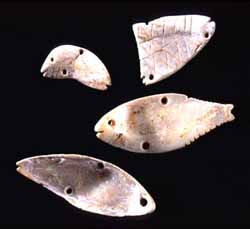
 |
Shell fish lures, Norris Farms #36, Fulton County. | |
|
These shell fish decoys were made about A. D. 1300, and they were likely used for ice fishing. The largest is slightly longer than three inches. A spilt antler jigging stick, for playing the decoy in the water, was found with one of these decoys. At present, they are the southernmost Protohistoric fish decoys known. |
||
Oneota people living at the Morton site fashioned fish lures out of both freshwater mussel shell and marine shell. These lures are detailed replicas of fish, complete with lines depicting eyes, mouths, gills, and sometimes scales.
By the 17th century, Caborn-Welborn people had a few French trade goods, including gunflints, glass beads, and metal objects. Soon thereafter, European trade goods replaced many of the traditional Native American tools and utensils.
|
|
Copyright © 2000 Illinois State Museum